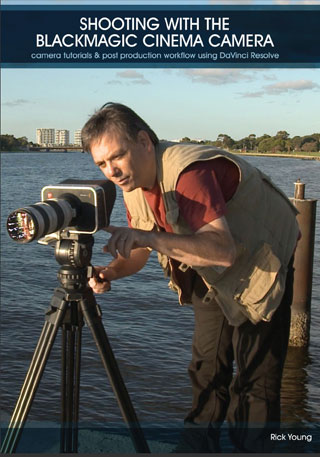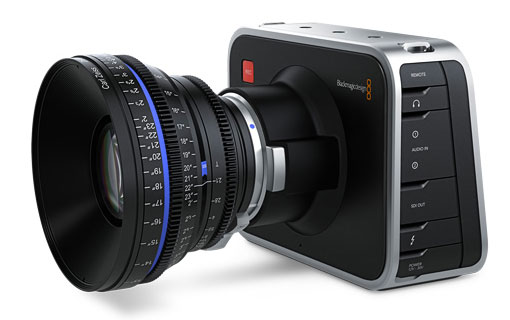
January 30, 2013
Camera tutorials & post production workflow using DaVinci Resolve
Featuring 2K cinema workflow
Written by Rick Young
95 page downloadable PDF $9.95
Review by Ken Stone
When Final Cut Pro first shipped over a decade ago, the only formats that it could work with were DV NTSC and PAL, which had an aspect ratio of 4:3 and were interlaced. FCP has grown up and is now a very modern NLE working with all of the professional codecs and formats. The cameras that we shoot with have also grown up as well.
The evolution of the video camera over this time period has been nothing short of spectacular. We've gone from DV (4:3) to HD (16 x 9), from Interlaced to Progressive, and from tape to file format memory cards. The number of formats and codecs that cameras now shoot has greatly expanded. One of the latest advancement of affordable video cameras is that we now have cameras that accept interchangeable lenses. And while the quality of the video shot on these new cameras has gone way up, the price has come way down.
One of the newest cameras to hit the market comes from Blackmagic of Australia, a respected and long time supplier of video capture cards and accessories. In recent years Blackmagic has made a string of acquisitions including DaVinci Resolve, ATEM Vision Mixers, and Teranex image processors. The release of the Blackmagic Cinema Camera represents a new and bold direction for the company.
The first time you see this camera you'll notice that it does not look like traditional video cameras, it is a strange looking animal. Designed from the ground up, it's a matter of 'form follows function'. The camera shoots to an SSD drive. The back of the camera sports a dual purpose LCD screen, which presents both the video image and menus for camera set up, gone is the flip out LCD screen. Importantly, it accepts interchangeable lenses. The camera ships in two different models, either EF or Passive Micro Four Thirds mounts. Another unique feature of the camera is its shooting formats, 2.5K RAW, ProRes HQ for FCP and DNxHD for Avid.

The price of the Blackmagic Cinema Camera is $3,000.00, but what I find most amazing about the Blackmagic Cinema Camera is the fact that it can shoot 12 bit RAW format with 13 stops of dynamic range. It shoots 2.5K with a frame size of 2432 x 1366. Now I'm a still photographer and I have worked with RAW images but never in a NLE. In fact, neither FCP nor Avid can work with RAW video. The Blackmagic Cinema Camera ships with a full version of DaVinci Resolve which works with the RAW footage and exports to codecs that NLEs can work with.
So here we have a brand new camera, very different from anything that we have worked with before. It shoots RAW video, which requires the use of color correcting software like DaVinci Resolve software. What we really need is a Blackmagic Cinema Camera book that tells us the story behind this camera, a thorough walk through of the camera, menus, ports, rigging, etc. Most importantly, we need DaVinci Resolve workflows, for shooting RAW, basic color grading and exporting. We need to learn the cinema workflow from start to finish and editing 2K video in FCP X.
Fortunately we now have just such a book. 'Shooting with the Blackmagic Cinema Camera', by Rick Young. Rick has been shooting with the BMCC for several months now and has written a very comprehensive tome that covers the origins and history of this camera, complete with interviews, practical camera information, menu setup, controls, SSD drive information, peripheral hardware, mics, handles, lights, brackets, batteries, audio, etc.
Some basic Blackmagic Cinema Camera information is available, but what this book offers is not available anywhere else. If you are shooting ProRes for FCP X or DNxHD for Avid, no problem. But, if you are shooting RAW, it's a whole new world. Rick walks you through the entire Cinema workflow, from ingest into DaVinci Resolve, to basic color correction and then output. Of great importance is his '2K Cinema workflow', which enables you to color correct in Resolve and export as 2K ProRes HQ, 2,048 x 1,152, and then edit 2K in FCP X. Rick provides step by step instructions for this entire process, screen shots of each step are included.
|
|
The book includes interviews with Grant Petty, CEO of Blackmagic and others involved with the development of the camera. These interviews give valuable camera information and explain the philosophy behind this new camera and what Blackmagic is striving for with its first venture into camera manufacturing. There are interviews with other shooters working with the camera and Rick's personal experiences shooting in locations as varied as Australia, Lisbon Portugal and the UK, using Nikkor and Canon glass, working with both the ProRes and RAW workflow. At the end of the book are links to 8 videos that include interviews but also test footage from the Blackmagic Cinema Camera.
There is a lot of very practical and valuable information in this book, it's a good read, but the Cinema DaVinci Resolve workflows, Featuring a 2K Cinema Workflow, is worth the $9.95 all by itself. If you are interested in this camera, in general or for the possibility of buying one, this book is useful. If you plan on shooting with this camera and editing in FCP X, then this book is indispensable.
I have seen and worked with footage off the Blackmagic Cinema Camera and I have to say that I am very impressed. The 12 bit RAW format, with 13 stops of dynamic range, opens up a whole new world of color correcting, enabling you to pull out visual detail and correct exposure not possible with video shot with codecs that compress the video. It's a new world for the indie film maker.
Enjoy,
--ken